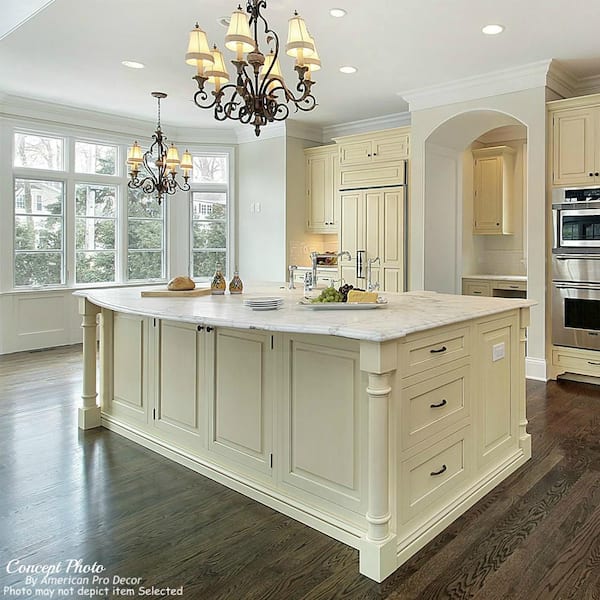An Overview to Selecting the Perfect Legs For Kitchen Area Island for Your Home
Picking the suitable legs for your kitchen island is a nuanced choice that influences both the functionality and visual allure of this main space. As you take into consideration these elements, it comes to be apparent that the ideal legs can change not only the look of your cooking area but likewise its use for years to come.

Recognizing Kitchen Area Island Legs
When selecting legs for a cooking area island, it's necessary to recognize their visual and functional duties in the overall layout. The legs serve as a critical support system, making certain stability and resilience for the island, which usually works as a workspace, dining location, or collecting spot. The choice of product and building and construction technique need to be durable enough to stand up to day-to-day usage and prospective wear.
In enhancement to their structural obligations, legs add dramatically to the island's visual appeal. They can improve the kitchen's design, whether with standard, contemporary, or diverse layouts. The elevation and percentage of the legs are additionally critical considerations; they need to integrate with the island's kitchen counter elevation while ensuring comfortable seating for those using the space.
Furthermore, the leg style can influence the overall flow of the kitchen area. Open, airy leg styles can create a sense of agility, while strong, substantial legs may convey a more grounded and secure visual - Legs For Kitchen Island. Recognizing these useful and visual aspects will certainly assist home owners in making notified choices that enhance their kitchen's design and improve its functionality
Popular Styles and Materials
The choice of legs for a kitchen island encompasses a variety of preferred designs and products, each offering one-of-a-kind features that can boost both performance and looks. Among the most desired styles are modern, rustic, and standard. Contemporary legs typically feature streamlined, minimalist layouts that highlight simpleness and tidy lines, making them perfect for modern-day kitchen areas. Rustic styles, on the other hand, welcome natural environments and commonly showcase redeemed wood or distressed finishes, adding heat and charm to the space. Standard legs generally show ornate information and craftsmanship, boosting traditional cooking area styles.
:max_bytes(150000):strip_icc()/pink-marble-tile_House-of-Harvee-9f030193ae38484a9cb7ea2d71af66f4.jpg)
Elevation and Security Factors To Consider

The legs of the cooking area island should give appropriate assistance, making certain that the structure can stand up to everyday usage without tottering or shifting. Product option plays a significant function in security; steel legs, for instance, tend to use better strength compared to wood.
Matching Your Kitchen Area Visual
Picking the best legs for your cooking area island goes beyond functionality; it also plays a considerable duty in the overall aesthetic of the area (Legs For Kitchen Island). When selecting legs, think about the design style of your kitchen area.
Color is another essential variable. Legs that enhance or comparison with your island's surface and bordering kitchen cabinetry can produce visual consistency or striking prime focus. For example, pairing dark timber legs with a light marble kitchen counter can include deepness and rate of interest. Furthermore, consider the finish of the legs; matte, shiny, or distinctive surfaces can considerably impact the overall feeling of the kitchen area.
Installment and Maintenance Tips
Setting up kitchen island legs calls for cautious focus to detail to make certain both stability and visual appeal. Utilize a stud finder to situate wall studs if you are connecting the legs to a wall surface or utilizing braces for included support.
When protecting the legs, make use of top notch screws and, if necessary, wood adhesive for additional stamina. For steel legs, make certain that you are using ideal anchors and tools to avoid damage to your floor covering. It is recommended to examine for levelness after installation, making modifications as required to avoid tottering.
Maintenance is similarly vital for longevity - Legs For Kitchen Island. On a regular basis check the legs for any type of indicators of wear or loosening, particularly in high-traffic areas. Clean the legs with an appropriate cleaner, staying clear of unpleasant products that may scratch the surface. For wooden legs, think about using a timber conditioner regularly to keep their coating. By adhering to these installment and upkeep tips, you can ensure that your kitchen island legs remain both practical and visually appealing.
Conclusion
In conclusion, picking the suitable legs for a why not try here kitchen area island necessitates mindful factor to consider of height, security, and visual compatibility. By choosing suitable materials and designs that line up with the overall cooking area layout, performance can be boosted while maintaining aesthetic allure. Appropriate installation and recurring upkeep even more add to the durability and long life of the kitchen area island. Ultimately, thoughtful leg option plays a vital role in boosting both the functionality and design of the cooking area area.
When selecting legs for a cooking area island, it's important to recognize their practical and visual duties in the overall layout. Open, airy leg styles can develop a sense of lightness, while strong, substantial legs may share a more based and secure aesthetic. The legs of the kitchen area island need to offer appropriate support, making certain that the structure can stand up to day-to-day use without changing or tottering.Installing kitchen area island legs calls for careful attention to detail to ensure both stability and visual allure.In conclusion, choosing the proper legs for a cooking area island demands careful you could try these out consideration of height, stability, and visual compatibility.